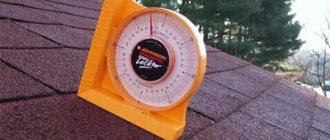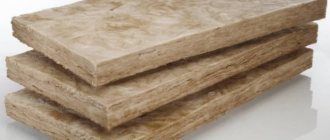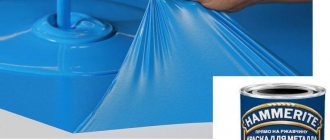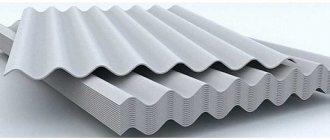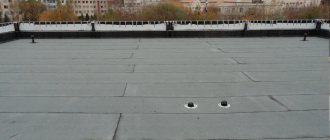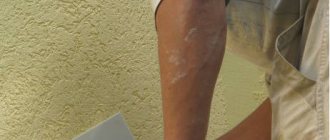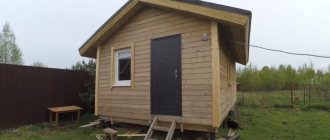No one is surprised by the situation when the snow mass on the roof makes you nervous, climb onto the roof and remove the accumulated layer of snow. Even if the snow load was calculated based on the maximum value during installation of the roof, construction of the base and roof frame of the building, in accordance with the recommendations of SNiP 2.01.07-85, common sense dictates that you should not check the validity of the formulas on your home.
For areas with large amounts of precipitation, pitched roofs clearly have advantages over flat structures, if only because most of the snow mass at large angles of inclination is simply blown away by the wind or slides down.
Types of roof loads
The main loads affecting the roof are:
- Snow weight.
- Wind load.
They have varying degrees and nature of impact on the roof and the rafter system as a whole. The snow load is more static, all changes occur relatively slowly and smoothly. The only exception may be the avalanche-like descent of large snowdrifts, characteristic of modern types of metal roofing. In addition, the snow remains for several months, and there is no load in the summer.
Snow cover falling from the roof in an avalanche Source pinterest.co.uk
For the wind, the season does not matter; it can rise in both winter and summer. The wind is dangerous because of its unpredictability; it is impossible to foresee it and somehow prepare for it. Most often, strong winds do not last long, but the consequences are very dire. At the same time, strong gusts that create noticeable pressure on the structure of the house occur relatively rarely.
In most cases, the wind load is minimal and does not have a constant value. The episodic nature and unevenness of wind manifestations create significant difficulties in determining the real load on the structure of a house, therefore it is customary to take into account the maximum tabulated values for a given region.
Destructive consequences of neglecting calculations Source akademija-art.hr
Dependence of loads on the angle of roof inclination
Snow and wind loads have an inverse relationship with the angle of the roof. The wind is directed parallel to the surface of the earth; any vertical objects interfere with it. Snow falls on the plane and presses on it in the direction from top to bottom. Therefore, the steeper the angle of inclination of the roof slopes, the greater the wind loads and, conversely, the weaker the pressure of snowdrifts. Therefore, to reduce wind loads, it is necessary to reduce the angle of inclination, and to reduce snow loads, to increase it.
Such a discrepancy requires the designer to have accurate knowledge of the amount of snow cover and the strength of the prevailing winds in the region, the possibility and frequency of squalls. Otherwise, you can end up with a roof that is too steep, forming a strong sail, or too flat, preventing snow from rolling down the inclined plane.
The roof should be designed taking into account the possibility of snow rolling down an inclined plane Source pxhere.com
Why are snow loads dangerous?
High snow loads are dangerous in several ways:
- Creating excessive pressure on the rafter system, causing deflection , sagging of the roof or destruction of the load-bearing elements of the roof.
- The appearance of additional load on the walls of the house , and through them - on the foundation .
- A large weight of snow is dangerous when snowdrifts suddenly fall from the roof, as people , cars or other property .
In addition, a large amount of snow begins to melt as the temperature rises, forming a layer of ice on the roof surface. It is dense and heavy, holds well on the surface, gradually increasing its thickness. During thaws, this ice rolls down and causes severe damage to all objects on which it falls. It must be remembered that a relatively thin layer of ice of 5 cm on the surface of a slope with an area of 20 m2 weighs about a ton.
Calculation of the snow load on a flat roof shows the magnitude of the impact of snow on the horizontal plane. The angle of inclination of the slopes is taken into account by special coefficients. It is believed that with a slope of more than 75° there is no snow load, although in practice wet snow can also stick to vertical planes. This is where another danger lurks, when the structures of the house are unprepared to receive significant pressure.
Life-threatening uncontrolled snowfall Source www.staffaltay.ru
See also: Catalog of companies that specialize in roof repair and design.
Varieties
Snow guards for metal roofs may vary in shape, size and reliability of the design. To begin with, when choosing, you need to focus on what volumes of snow it will need to hold back.
The following types of snow guards for metal tiles are manufactured:
Tubular. In appearance, they look like brackets into which pipes with a diameter of 15-30 mm are inserted. The entire height of this structure is 15 cm. At the bottom of the bracket there is a horizontal shelf, which is necessary for attaching the roof slopes. It is into this that the screw with a hexagonal head for metal (8*60 mm) will be screwed. In order for the installation of snow retainers on metal tiles to be durable, you need to calculate the optimal distance from 2 to 3 cm, and from the roof to the first pipe 8-10 cm between the pipes.
Tubular snow retainers for metal tiles should be installed on roofs with a slope of up to 60 0. Indeed, in such cases, the snow pressure will be very high, and the process of snow melting will be frequent. They are the most durable, only they are subject to bending under the pressure of a block, which certainly will not happen with other structures (the reliability is affected by the shape of the brackets and their guides). In roofs with a slope of more than 60 0, snow guards are not installed at all; snow does not linger in them at all, but falls instantly.
Lattice. This type of snow retainer for metal tiles has different sizes. The most universal type of design is brackets to which a vertical grille is attached. All parts are made of galvanized steel, and they are painted on top (so that the gratings match the roof). The largest, in terms of height, they range from 15-20 cm, but there are also small ones from 5-7 cm, they are mounted on long slopes that have a large slope. This design can provide a guarantee that it will keep snow from falling, and the effectiveness will directly depend on the height of the grate.
Point snow stops for metal tiles are a new type, they are also called snow stops. It is recommended to install 5-8 pieces per square meter and supplement them with a snow-retaining grid. The main task is the same arrangement of snow and all its pressure on the roof. The design is produced in various types of shapes and with an individual bracket.
Corner snow guards for metal tiles. This type is bent into a triangular shape, and has two sides with shelves for fastening to the base. The height ranges from 4-6 cm. Most often, snow retainers are attached to metal tiles where the slope angle is not higher than 30 0, because they cannot withstand greater pressure. The structure is attached directly to the roofing material. Installation is carried out along the length of the skates in a checkerboard pattern in several rows (starting from two rows), the distance between them ranges from 50 cm to 1 meter. This type of structure is fragile and will not be able to hold larger layers of snow. In this regard, corner snow retainers are used in those regions where there is little precipitation.
Features of snow load distribution on the roof surface
The snow load is distributed differently on the roof surface, evenly over the entire area, or with a noticeable skew to the leeward side. Sometimes huge overhanging layers grow on the slopes, which create corresponding pressure on the eaves of the roof.
Distribution of snow load on the roof surface Source obustroeno.com
Such distortions can deform or destroy rafter structures and create significant pressure on the foundation. It is necessary to understand that a uniform load from the weight of snow affects the structure of the house in an extremely unfavorable way. There are regions where the thickness of the snow cover exceeds 2 m. In such conditions, it is extremely important to take the correct angles of inclination of the slopes so that the snow masses can roll off them without reaching excessive thickness and without creating an unbearable load on the supporting structures.
Snow cover of more than 2 meters is an unbearable load for supporting structures Source ko.decorexpro.com
Installation of snow guards
If the calculation is done correctly, then there is no need to remove snow from the roof surface. And to combat it from sliding off the eaves, snow retainers are used. They are very easy to use and eliminate the need to remove snow from the roof of the house. In the standard version, tubular structures are used, which are capable of operating if the standard snow load does not exceed 180 kg/m2. For denser weights, install snow guards in several rows. SNiP stipulates the use of snow guards:
- with a slope of 5% or more with external drainage;
- snow guards are installed at a distance of 0.6-1.0 meters from the edge of the roof;
- When using tubular snow retainers, a continuous roof sheathing must be provided underneath them.
Be sure to read: Basic principles for calculating a rafter system
SNiP also describes the basic designs and geometric dimensions of snow guards, their installation locations and operating principles.
Determination of snow pressure on the roof according to SNiP
When it becomes necessary to determine what snow load on the roof exists in a given region, a lot of questions immediately arise. First of all, how can you find out the amount of snow cover? Direct measurement with a ruler will not provide useful information - each winter has its own characteristics, there are seasons with little snow, when the level of precipitation is less than usual.
The magnitude of snow impact can be determined using SNiP applications. There is a map of the Russian Federation, in which all regions with the same amount of snow cover are outlined and numbered. Let's look at the current version of this application:
Map of SNIP of the Russian Federation with regions having the same amount of snow cover Source stroy-okey.ru
To determine the snow pressure on the roof, you need to find the point of interest on the map and find out which snow region it belongs to. Then we use the table:
| Snowy regions of the Russian Federation | Load value kg/m² |
| 1 | 80 |
| 2 | 120 |
| 3 | 180 |
| 4 | 240 |
| 5 | 320 |
| 6 | 400 |
| 7 | 480 |
| 8 | 560 |
If the roof area is known, then determining the weight of the snow is not difficult - you just need to divide it by the tabular value for a given region. But the resulting value shows the load on the horizontal plane. A correction factor is used to take into account the angle of inclination. It was found empirically and has the following meanings:
- At an inclination angle of up to 25° – 1.
- At an angle of inclination from 25 to 60° – 0.7.
- When the angle of inclination is more than 75° – 0.
The zero value of the correction factor is accepted because it is believed that such a slope ensures that snow falls off the slopes independently and there is no pressure. For such roofs, snow retainers are often used to prevent too much snow from falling off.
Snow guards prevent massive snow sliding Source umnik.spb.ru
Specific gravity: such light and heavy snow
Now let's move on to practice. If you live in Russia, and not on the southern continent without winter, then you know what snow really is: incredibly light and incredibly heavy. For example, the same fluffy snowball in frosty and dry weather at a temperature of -10°C will have a density of about 10 kg per cubic meter. But the snow at the end of autumn and at the beginning of winter, which had been lying on horizontal and inclined surfaces for a long time and “packed”, already has a much greater mass - from 60 kilograms per cubic meter. By the way, it is not difficult to find out the density of snow - in winter it is enough to cut out a one cubic meter sample of snow with a large shovel and weigh it.
If we are talking about loose snow, which, in theory, is light and does not cause problems, then know that there is some danger lurking here. Loose snow, like no other, quickly absorbs all precipitation in the form of rain and becomes wet snow. And its presence on the roof, where there is no properly organized drainage, is fraught with big problems.
Further, in the spring, during a long thaw, the specific gravity of snow also increases significantly. Dry compacted snow has an average density ranging from 200 to 400 kg per cubic meter. Also, do not miss such an important moment when the snow remained on the roof for a long time and there was no new snowfall, and you did not remove it. Then, regardless of its density, it will have the same mass, although visually the “cap” itself has become half the size. In a particularly humid climate in spring, the specific gravity of snow reaches 700 kg per cubic meter!
Snow load calculation online calculator
There is another way to calculate the weight of snow on the roof. This is the use of an online calculator, a specialized resource that automatically performs calculations based on the user’s initial data. Debates about the usefulness of online calculators have been going on since the very first day of their appearance. Most users are convinced that, if necessary, to perform a high-quality calculation of the snow load on the roof, the calculator is useless.
Relying on an unknown algorithm in such a critical matter is dangerous. Proponents of the use of these resources argue that the criterion for the quality of work of such resources can be duplication of calculations on other calculators. It is difficult to say for sure which of them is right. However, given the relative simplicity of self-calculation, it is much more correct to perform these few arithmetic operations yourself.
Independent calculation of the snow load on the roof Source umnik.spb.ru
Calculation of snow load on a roof in the Moscow region
As an example, let's look at how the snow load on a roof is calculated in the Moscow region. Initial data:
- House with two slopes , total roof area 64 m2.
- The slope angle is 36°.
Using a map of snow areas, we determine which of them the Moscow region belongs to. This is the 3rd district. According to the table, we obtain a specific load value equal to 180 mg/m2.
64 × 180 = 11520 kg.
The resulting value must be multiplied by the slope coefficient. In the case under consideration, it is equal to 0.7. Then we get:
11520 × 0.7 = 8064 kg.
The weight of the snow will be 8t and 64kg. As you can see, this calculation is not difficult at all; you literally need to perform 2 steps.
Simple, understandable arithmetic operations for calculating the snow load Source domik.ua
Table of snow and wind areas by Russian cities
| Subject of the federation | City | Snow area | Wind district |
| Adygea | Maykop | 2 | 1 |
| Altai region | Barnaul | 4 | 3 |
| Altai region | Biysk | 4 | 1 |
| Altai region | Rubtsovsk | 3 | 3 |
| Amur region | Blagoveshchensk | 1 | 3 |
| Arhangelsk region | Arkhangelsk | 4 | 2 |
| Arhangelsk region | Severodvinsk | 4 | 2 |
| Astrakhan region | Astrakhan | 1 | 3 |
| Bashkortostan | Neftekamsk | 5 | 2 |
| Bashkortostan | Salavat | 5 | 3 |
| Bashkortostan | Sterlitamak | 5 | 3 |
| Bashkortostan | Ufa | 5 | 2 |
| Belgorod region | Belgorod | 3 | 2 |
| Belgorod region | Stary Oskol | 3 | 2 |
| Bryansk region | Bryansk | 3 | 1 |
| Buryatia | Ulan-Ude | 1 | 3 |
| Vladimir region | Vladimir | 3 | 1 |
| Vladimir region | Kovrov | 4 | 1 |
| Vladimir region | Moore | 3 | 1 |
| Volgograd region | Volgograd | 2 | 3 |
| Volgograd region | Volzhsky | 2 | 3 |
| Volgograd region | Kamyshin | 3 | 2 |
| Vologda Region | Vologda | 4 | 1 |
| Vologda Region | Cherepovets | 4 | 1 |
| Voronezh region | Voronezh | 3 | 2 |
| Dagestan | Derbent | 2 | 5 |
| Dagestan | Makhachkala | 2 | 5 |
| Dagestan | Khasavyurt | 2 | 5 |
| Transbaikal region | Chita | 1 | 2 |
| Ivanovo region | Ivanovo | 4 | 1 |
| Irkutsk region | Angarsk | 2 | 3 |
| Irkutsk region | Bratsk | 3 | 2 |
| Irkutsk region | Irkutsk | 2 | 3 |
| Kaliningrad region | Kaliningrad | 2 | 2 |
| Kalmykia | Elista | 2 | 3 |
| Kaluga region | Kaluga | 3 | 1 |
| Kaluga region | Obnisk | 3 | 1 |
| Kamchatka Krai | Petropavlovsk-Kamchatsky | 7 | 7 |
| Kemerovo region | Kemerovo | 4 | 3 |
| Kemerovo region | Kiselevsk | 4 | 2 |
| Kemerovo region | Leninsk-Kuznetsky | 4 | 3 |
| Kemerovo region | Novokuznetsk | 4 | 3 |
| Kemerovo region | Prokopyevsk | 4 | 2 |
| Kirov region | Kirov | 5 | 1 |
| Kostroma region | Kostroma | 4 | 1 |
| Krasnodar region | Krasnodar | 2 | 6 |
| Krasnodar region | Novorossiysk | 2 | 5 |
| Krasnodar region | Sochi | 2 | 4 |
| Krasnoyarsk region | Achinsk | 4 | 3 |
| Krasnoyarsk region | Krasnoyarsk | 3 | 3 |
| Krasnoyarsk region | Norilsk | 5 | 3 |
| Kurgan region | Mound | 3 | 2 |
| Kursk region | Kursk | 3 | 2 |
| Leningrad region | Saint Petersburg | 3 | 2 |
| Lipetsk region | Dace | 3 | 2 |
| Lipetsk region | Lipetsk | 3 | 2 |
| Magadan Region | Magadan | 5 | 5 |
| Mari Republic | Yoshkar-Ola | 4 | 1 |
| Mordovia | Saransk | 3 | 2 |
| Moscow region | Balashikha | 3 | 1 |
| Moscow region | Railway | 3 | 2 |
| Moscow region | Zhukovsky | 3 | 1 |
| Moscow region | Kolomna | 3 | 1 |
| Moscow region | Krasnogorsk | 3 | 1 |
| Moscow region | Lyubertsy | 3 | 1 |
| Moscow region | Moscow | 3 | 1 |
| Moscow region | Mytishchi | 3 | 1 |
| Moscow region | Noginsk | 3 | 1 |
| Moscow region | Odintsovo | 4 | 1 |
| Moscow region | Orekhovo-Zuevo | 3 | 1 |
| Moscow region | Podolsk | 3 | 1 |
| Moscow region | Serpukhov | 3 | 1 |
| Moscow region | Khimki | 3 | 1 |
| Moscow region | Shchelkovo | 3 | 1 |
| Moscow region | Elektrostal | 3 | 1 |
| Murmansk region | Murmansk | 5 | 4 |
| Nizhny Novgorod Region | Arzamas | 4 | 2 |
| Nizhny Novgorod Region | Dzerzhinsk | 4 | 1 |
| Nizhny Novgorod Region | Nizhny Novgorod | 4 | 1 |
| Novgorod region | Velikiy Novgorod | 3 | 1 |
| Novosibirsk region | Novosibirsk | 4 | 3 |
| Omsk region | Omsk | 3 | 2 |
| Orenburg region | Orenburg | 4 | 3 |
| Orenburg region | Orsk | 4 | 2 |
| Oryol Region | Eagle | 3 | 2 |
| Penza region | Penza | 3 | 2 |
| Perm region | Permian | 5 | 2 |
| Primorsky Krai | Artem | 3 | 4 |
| Primorsky Krai | Vladivostok | 2 | 4 |
| Primorsky Krai | Nakhodka | 2 | 5 |
| Primorsky Krai | Ussuriysk | 2 | 3 |
| Pskov region | Velikie Luki | 3 | 1 |
| Pskov region | Pskov | 3 | 1 |
| Republic of Karelia | Petrozavodsk | 2 | 5 |
| Komi Republic | Syktyvkar | 5 | 1 |
| Komi Republic | Ukhta | 5 | 2 |
| Rostov region | Bataysk | 2 | 3 |
| Rostov region | Volgodonsk | 2 | 3 |
| Rostov region | Novocherkassk | 2 | 3 |
| Rostov region | Novoshakhtinsk | 2 | 3 |
| Rostov region | Rostov-on-Don | 2 | 3 |
| Rostov region | Taganrog | 2 | 3 |
| Rostov region | Mines | 2 | 3 |
| Ryazan Oblast | Ryazan | 3 | 1 |
| Samara Region | Volzhsky | 4 | 3 |
| Samara Region | Novokuibyshevsk | 4 | 3 |
| Samara Region | Samara | 4 | 3 |
| Samara Region | Sizran | 3 | 3 |
| Samara Region | Tolyatti | 4 | 3 |
| Saratov region | Balakovo | 3 | 3 |
| Saratov region | Saratov | 3 | 3 |
| Saratov region | Engels | 3 | 3 |
| Sakhalin region | Yuzhno-Sakhalinsk | 4 | 4 |
| Sverdlovsk region | Ekaterinburg | 3 | 2 |
| Sverdlovsk region | Kamensk-Uralsky | 3 | 1 |
| Sverdlovsk region | Nizhny Tagil | 4 | 2 |
| Sverdlovsk region | Pervouralsk | 4 | 2 |
| North Ossetia | Vladikavkaz | 2 | – |
| Smolensk region | Smolensk | 3 | 1 |
| Stavropol region | Nevinnomyssk | 2 | 5 |
| Stavropol region | Stavropol | 2 | 5 |
| Tambov Region | Tambov | 3 | 2 |
| Tatarstan | Almetyevsk | 5 | 2 |
| Tatarstan | Kazan | 4 | 2 |
| Tatarstan | Naberezhnye Chelny | 5 | 2 |
| Tatarstan | Nizhnekamsk | 5 | 2 |
| Tver region | Tver | 4 | 1 |
| Tomsk region | Tomsk | 4 | 3 |
| Tula region | Novomoskovsk | 3 | 1 |
| Tula region | Tula | 2 | 1 |
| Tyva | Kyzyl | 2 | 1 |
| Tyumen region | Tobolsk | 4 | 2 |
| Tyumen region | Tyumen | 3 | 2 |
| Udmurtia | Izhevsk | 5 | 1 |
| Ulyanovsk region | Dimitrovgrad | 4 | 2 |
| Ulyanovsk region | Ulyanovsk | 4 | 2 |
| Khabarovsk region | Komsomolsk-on-Amur | 4 | 3 |
| Khabarovsk region | Khabarovsk | 2 | 3 |
| Khakassia | Abakan | 2 | 3 |
| Khanty-Mansi Autonomous Okrug | Nefteyugansk | 4 | 2 |
| Khanty-Mansi Autonomous Okrug | Nizhnevartovsk | 5 | 2 |
| Khanty-Mansi Autonomous Okrug | Surgut | 4 | 2 |
| Chelyabinsk region | Zlatoust | 4 | 2 |
| Chelyabinsk region | Kopeisk | 3 | 2 |
| Chelyabinsk region | Magnitogorsk | 4 | 3 |
| Chelyabinsk region | Miass | 3 | 2 |
| Chelyabinsk region | Chelyabinsk | 3 | 2 |
| Chechen Republic | Grozny | 2 | 4 |
| Chuvashia | Novocheboksarsk | 4 | 2 |
| Chuvash Republic | Cheboksary | 4 | 2 |
| Yakutia | Yakutsk | 2 | 2 |
| Yamalo-Nenets Autonomous Okrug | New Urengoy | 5 | 2 |
| Yamalo-Nenets Autonomous Okrug | Noyabrsk | 5 | 2 |
| Yaroslavl region | Rybinsk | 4 | 1 |
| Yaroslavl region | Yaroslavl | 4 | 1 |
